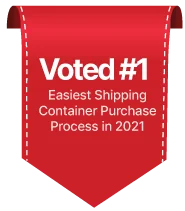Introduction: Abandoned Shipping Containers & Goods Sold
What happens to abandoned containers and abandoned cargo? There are many possible scenarios.
Typically, abandoned cargo can be publicly auctioned off or sold directly to cargo salvage buyers. An owner may have gone bankrupt or discarded their goods, and a container might be sitting idle at a port.
As a result, port authorities auction them off to free up space and earn money from storage. Typically, owners of abandoned containers have 20 days to claim them.
But what if the owner cannot be reached? Will the container be dumped?
Liability for Abandoned Cargo
Who is liable for abandoned cargo? The issue of liability for abandoned cargo is a major concern for freight importers. This type of cargo has a high risk of being abandoned in foreign ports, which is why safeguards should be put into place to ensure that the containers do not get abandoned.
The British International Freight Association has received many questions concerning these types of containers and has advised members to close files on all of their goods that were shipped and paid for with carriage. Shipping lines may then demand storage or quay charges.
The carrier may be able to discharge its liability for unclaimed cargo if it identifies a shipper’s lack of reliability. Similarly, it can cite local port regulations to help determine the reasons for abandoned cargo. In such cases, it is imperative to have liability insurance. Keeping these in mind is vital to your company’s continued success. The heightened risks can be avoided by knowing who is shipping your cargo.
Customs authorities & cargo abandoned
The new buyer should be able to enter the goods into the customs warehouse. Destruction of goods – the shipping company may destroy the goods; however, due to environmental protection regulations and the requirements of the Customs Act, it must obtain permission to dispose of the abandoned cargo.
While most abandoned cargo cases are easy to resolve, the costs could end up being much higher than the final payment. The time factor is vital, as every day that a container stays abandoned, the more likely it is to be claimed.
To minimize the risk of being sued for lost cargo, it is imperative that you and your freight forwarder have contracts that clearly identify the parties’ obligations. Furthermore, most contracts contain a force-majority clause. This clause allows a freight forwarder to invoke this clause in cases involving abandoned cargo.
Once the cargo is seized, the shipper can take legal action to recoup the difference. If the shipper fails to collect the full amount owed to them, a third party can step in and sell the cargo for a lower price. The third party could also try to recover the remainder of the monies owed. The shipper could be responsible for any shortfall of the amount recovered. In such a scenario, the shipper is held liable for any shortfall.
Shipping Company Taxes
There are a variety of taxes associated with buying containers that are abandoned. These costs incurred include demurrage fees for the goods that are parked at the port and disposal charges. These charges are both time-consuming and expensive for everyone involved.
Shippers are responsible for paying the charges. However, the shipper and the freight forwarder are not the only ones affected. The consignee, who had paid for the cargo, may be responsible as well.
Customs can also auction off the goods that have been left behind. They can sell them for parts, or sell them at auction.
The proceeds from the auction will go toward paying the related costs. If the shipper doesn’t claim the entire amount, the remaining money will be returned to the shipper or may be deposited into a state’s treasury. Regardless of the method chosen, the amount recovered may be taxable.
The International Federation of Freight Forwarders Associations defines abandoned goods as items that an importer has no intention of picking up. In the U.S., like in New York, Oklahoma, Alabama, Arkansas, and Colorado, a reasonable period is six months from the date of import.
For perishable goods, this period is less. But, even in the U.S., there are still taxes on abandoned goods & containers. While this may seem like a small amount of money, it still entails a substantial amount of money.
Auctioning off abandoned goods
Because international shipping is expensive, some buyers may decide to leave their cargo behind at the port and sell it at an auction. The buyer must agree to pay duties and taxes, if applicable.
Taxes on abandoned goods & containers are an additional burden for shippers. Fortunately, however, there are some ways to reduce this financial burden. By paying the difference and clearing the debt, shippers and freight forwarders can save both time and money.
Aside from the cost of shipping and unloading, there are other ways to recover taxes. Depending on the country, the shipping line is responsible for recovering the costs through local customs auctions.
Once the cost has been incurred, the shipping line must seek compensation from the local government after a specified period of time. However, jurisdiction is only an issue if a legal case is involved. The costs of recovering tax on a shipping container that is considered abandoned may include a legal case.
Sale to a new owner or shipping line
You may have heard of the phenomenon of buying and selling used containers, but you may not have considered what the process entails. Most shipping lines have their own protocol for how they deal with abandoned containers, but it can be tricky to get in on the action.
While it’s possible to purchase unclaimed freight from online retailers, shipping lines often do not want to part with their old equipment. You can, however, purchase a container for its cargo and sell it to a new owner.
There are several reasons why a shipping line will abandon a container. In some cases, the importer or owner cannot pay import duties, and sometimes the container will simply not be moving for some reason.
Other reasons include the container being unusable, damaged, or bankrupt, and even disputes with the consignee. In any case, the shipping line will incur additional storage costs and will sell the cargo at an auction to recoup some of its costs.
In some cases, the shipping company will seek a buyer for the goods in an abandoned container. In this case, the buyer will assume the responsibilities of Import Declaration and payment of duty and GST, and take delivery of the goods at a bonded warehouse.
If the buyer fails to pay these fees, the shipping company will need permission to dispose of the abandoned container, which can be complicated. So what are the options for a new buyer?
Verifying the credentials of the importer before accepting shipments Being wary of low-value or counterfeit goods that people don’t really want Having Freight Forwarders Liability Insurance to cover abandoned cargo.
There are three primary options for selling an abandoned shipping container. The first option is to return the shipping container to its point of origin. A second option is to sell the container to a new owner and receive a cash payment from the buyer. These two options are the most common and most profitable.
Depending on the circumstances, you may even be able to recover your costs. Once the shipping container is sold, you can either reposition it into service or resell it for a profit.
Environmental impact
Shippers and other businesses are accumulating thousands of empty shipping containers worldwide because of the linear trading system. Some of the abandoned containers have been dumped on agricultural land or waterways. But it’s not clear exactly where the containers ended up.
Some containers have been mapped to determine their precise locations, while others are discarded before they reach the shore. A survey of shipping container locations around the world will provide an accurate picture of the environmental impact of such containers.
Every year, hundreds of thousands of containers are left abandoned, causing port congestion and escalating logistics costs. According to the International Federation of Freight Forwarders Associations (FIATA), “abandoned goods” are goods that were never collected by their importer.
Abandoned goods can also include items that were refused collection by their importer. Aside from this, abandoned containers often contain perishable goods, which make them unusable in other countries.
Many of these containers end up in the sea, contaminating nearby water bodies. Mariners can breathe in this water, which can contain toxic chemicals and cause harmful algae blooms. In addition, containers can damage marine life and can cause invasive species to flourish.
Fortunately, the United States Coast Guard has a Joint Rescue Coordination Center in Honolulu, which is charged with investigating spills and other marine debris. However, the U.S. Coast Guard doesn’t investigate the dumping of containers, which is illegal.
Reduction of carbon footprint by the supply chain industry
Fortunately, the shipping industry and shipping companies are taking steps to make a difference. They are committed to reducing their carbon footprint by 40% by 2030, and they aim to be “net-zero” by the end of the century. By eliminating the need for new shipping, this goal will be easier to achieve.
Even if shipping becomes less common, the environmental impact of abandoned containers will still be felt by future generations. But that doesn't mean it's impossible.
Even though shipping containers aren’t considered permanent structures, they can still serve as temporary shelters. But they still don’t meet all of the environmental requirements of conventional houses.
For example, most shipping containers are too small to meet modern standards, requiring expensive steel reinforcements to keep them from crashing onto each other.
Despite the shortcoming, shipping container homes help contribute to a greener Earth by reducing carbon footprints and making it easier to recycle and use environmentally friendly products.






 147 People have requested shipping container pricing this week through TheShip
147 People have requested shipping container pricing this week through TheShip